Red fungi really stand out against a green meadow backdrop or against the browns of a decomposing log. We tend to be drawn to their brilliant coloring, and because of this, they feature widely in folktales, mushroom identification forums, and fungi stories. What does it mean, though, to be a red mushroom species? Does the color say anything about the mushroom itself? This guide delves into 12 of North America’s most striking red mushrooms, discussing their identifying features, habitats, and edibility.
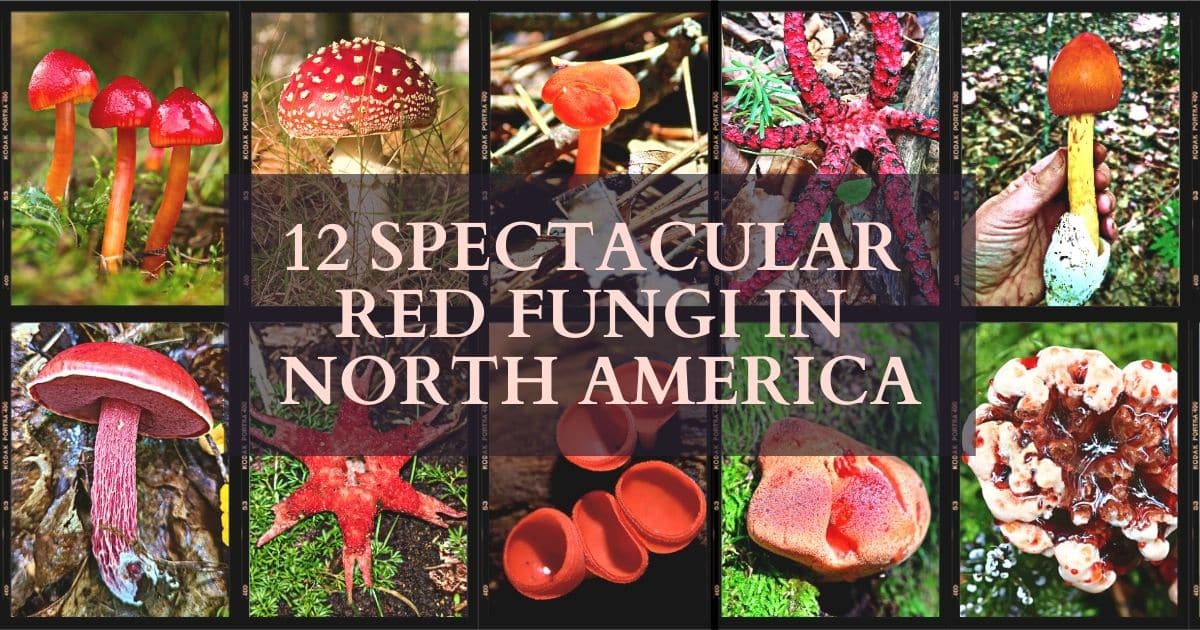
Jump to:
- Red Fungi 101
- 1. Amanita muscaria: The Iconic Fly Agaric
- 2. Russula emetica/Russula nobilis: The Sickener
- 3. Fistulina hepatica: Beefsteak Mushroom
- 4. Amanita jacksonii: Jackson’s Slender Amanita
- 5. Phallaceae: The Stinkhorn Mushrooms
- 6. Cantharellus cinnabarinus: The Cinnabar-Red Chanterelle
- 7. Butyriboletus frostii: Frost’s Bolete
- 8. Sarcoscypha coccinea: The Scarlet Elf Cup
- 9. Hygrocybe coccinea: The Scarlet Waxcap
- 10. Xerocomellus chrysenteron: The Red Cracking Bolete
- 11. Russula xerampelina: Crab Brittlegill
- 12: Hydnellum peckii, Devil’s Tooth
- Common Questions About Red Mushrooms
Red Fungi 101
Many people think red equals toxic, but this is not the case. There are definitely some red fungi that are poisonous, but there are also many that are edible. There are actually more non-red species that are dangerous as opposed to red ones. Each species is unique to itself. The only way to know if a mushroom is poisonous or edible is to identify it. Regardless of toxicity or edibility, though, red mushrooms pop in the woods and draw us to them with their brilliant colorations. Maybe that is why we pay them so much attention.
Mushroom coloring is a topic still not well understood. Researchers at the Technical University of Munich (TUM) and the Bavarian Forest National Park have begun to unravel the puzzle of mushroom coloration. In the natural world, coloration is usually purposeful: the fire salamander’s patterns signal its toxicity, while red cherries attract birds to spread their seeds. Chameleons, on the other hand, use their coloring to hide from predators. Temperature and climate is also a factor in coloring, with insects and reptiles in colder climates being darker—this is because cold-blooded animals use the ambient temperature to regulate their body temperature, and dark coloration allows them to absorb heat quickly.
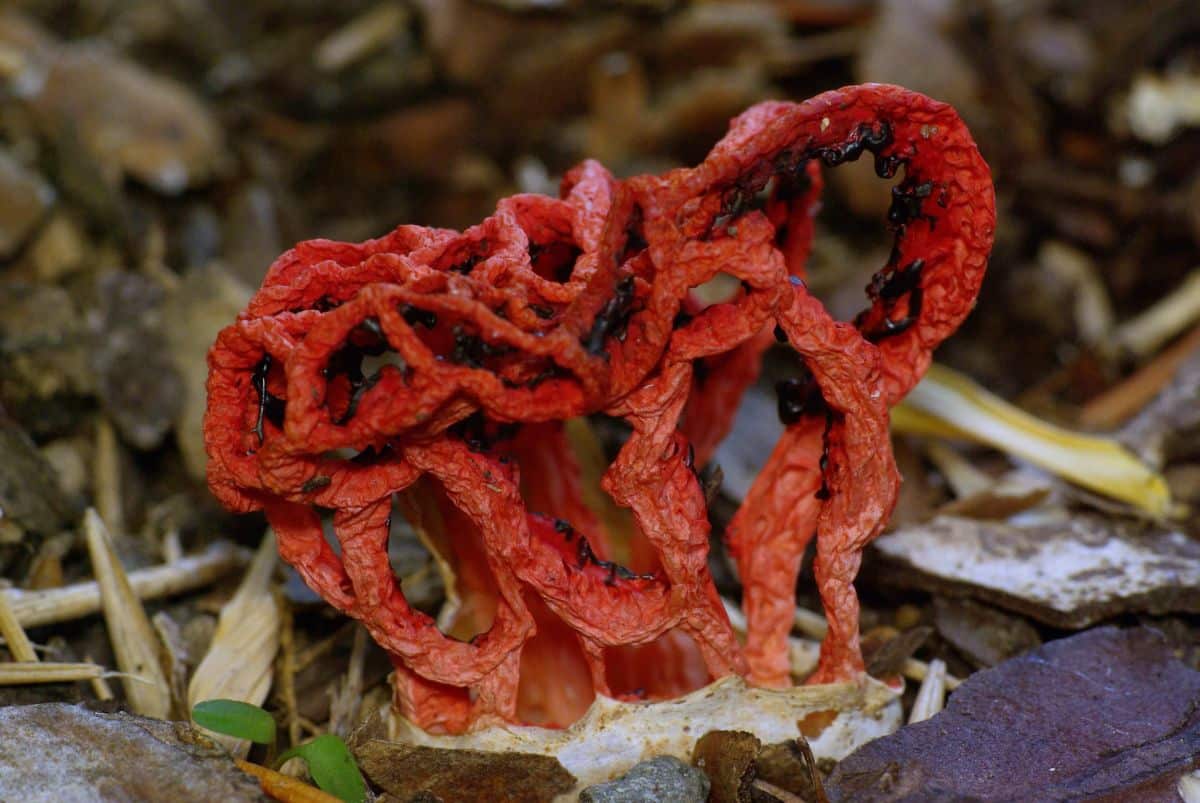
It is thought that this same mechanism could be at play in fungi. In the mushroom world, stinkhorns are some of the most unusual, (often) bright red, peculiar shaped fungi. This is to draw in flies that will eat the slimy spore mass and fly to a new location to defecate, allowing the spores to germinate in a nitrogen-rich substrate. So, the red is used to draw in insects that are beneficial to mushroom’s reproduction. Stinkhorn species are also more diverse and common in tropical climates. They do show up in cooler climates, but usually only when the summer temperatures are at their peak.
To test this idea of climate and coloration, the research team analyzed data from 3054 species of fungi found in Europe. They noted the coloration of the fungi and the climatic conditions of their habitats, and found a clear correlation: the fungi in colder climates were darker. The team also accounted for seasonal changes, and found that mushrooms that decompose dead plant matter were darker in the spring and autumn than in the summer. Further research is needed to fully understand mushroom colors, such as the degree to which dark coloration affects the reproductive rate of fungi. Read more about this study
But, maybe mushrooms come in fantastic shapes and colors just to make the planet more beautiful and increase our desire to conserve it.
1. Amanita muscaria: The Iconic Fly Agaric
- Scientific Name: Amanita muscaria
- Common Name: Fly agaric
- Habitat: Deciduous and coniferous forests
- Toxicity: Toxic
Amanita muscaria, commonly known as the Fly Agaric, is a red fungus recognized worldwide for its distinctive red cap adorned with white spots. This striking appearance has made it a popular symbol in fairy tales (usually accompanied by a toad) and video games.
When young, the fly agaric appears as a white egg emerging from the ground. As it matures, the cap breaks open the egg and expands to a vibrant red cap that grows up to 8 inches wide. The cap starts out rounded, then gradually broadens and flattens as the fungus matures. It is covered with cottony white patches that look like warts; these sometimes wash away in heavy rain. The gills beneath the cap are white, as is the stem.
This red fungus is widely spread across the globe and is typically found in both deciduous and coniferous forests. It is toxic but not deadly. Some people consume it hoping for a fantastical hallucinogenic experience, but more often, it brings unpleasant gastrointestinal distress and not much fun.
It contains psychoactive compounds like muscimol and ibotenic acid, which can lead to hallucinations and other neurological symptoms. Ingestion can lead to severe symptoms like vomiting, delirium, and even coma.
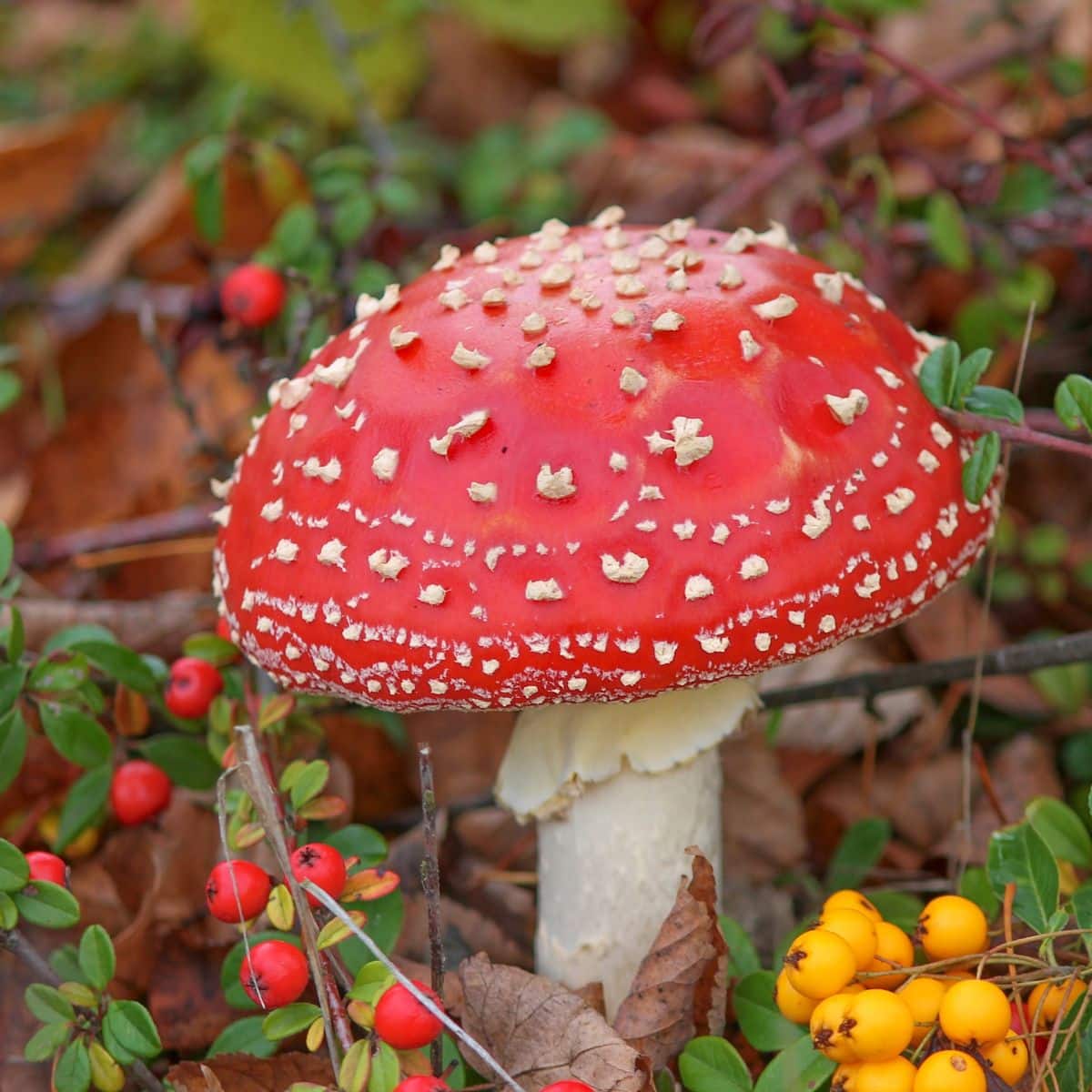
2. Russula emetica/Russula nobilis: The Sickener
- Scientific Name: Russula nobilis
- Common Name: The sickener
- Habitat: Coniferous and hardwood forests
- Toxicity: Toxic
Russula emetica, also known as the Emetic Russula or The Sickener, is a red mushroom commonly found in coniferous and hardwood forests worldwide, particularly in Europe, North Africa, and parts of Asia. Russula emetica may or may not be present in North America; many think reports of it are confused with the red-capped sickener species that IS in North America, Russula nobilis.
Russula nobilis is widespread in North America and grows primarily with beech trees. It is commonly known as the Beech Sickener, as it is also toxic.
The sickener is known for its cherry-red cap that grows up to 3.3 inches at maturity. The cap shape starts out convex in young specimens and then flattens out in mature ones. The red mushroom’s gills are white, becoming yellowish as the mushroom matures, and are attached to a sturdy, white, cylindrical stem.
The sickener prefers humid regions and forms a mycorrhizal relationship with tree roots, which provide sugars to the fungus in exchange for water and mineral nutrients from the soil.
Despite their appealing looks, both these species are moderately toxic. Eating these red fungi may lead to unpleasant symptoms like nausea, vomiting, diarrhea, and severe abdominal cramps. They won’t kill you as they’re not deadly poisonous, but you’ll definitely regret eating them.
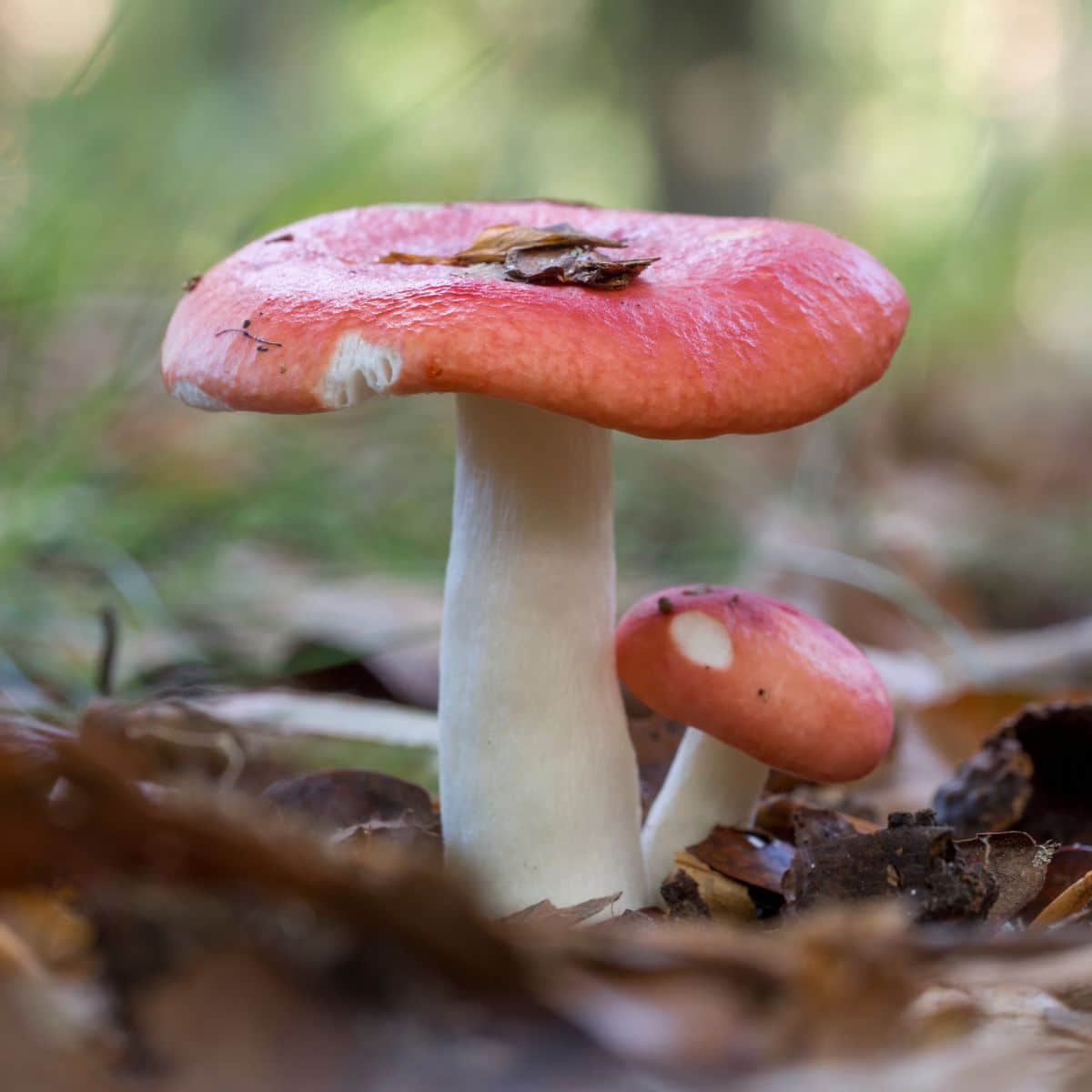
3. Fistulina hepatica: Beefsteak Mushroom
- Scientific Name: Fistulina hepatica
- Common Name: Ox tongue, Beefsteak, Tongue mushroom
- Habitat: Rotten stumps or tree trunks, particularly of chestnut or oak trees
- Toxicity: Non-toxic
Fistulina hepatica, also known as Ox Tongue or Beefsteak, is an edible red fungi species found throughout Europe, North America, Africa, and Australia. Its peculiar shape and reddish color make it look very eerily like a slab of raw meat attached to a tree. Or, a tree sticking its large brick red tongue out at you.
The Beefsteak is characterized by its large, brown to reddish-brown fruiting bodies. It has a fleshy, lobed body that can reach up to nearly 12 inches in diameter. Its surface is reddish, rough, and lacks gills. It’s attached directly to a host without a stem.
Beefsteak mushrooms are saprophytic and parasitic fungi, feeding on dead organic matter like decaying fallen tree trunks and dry branches. They prefer moist environments and are often spotted in early spring.
This edible mushroom is sometimes used as a meat substitute because it has a meaty texture and red juice that oozes out when cut, resembling blood. The taste, though, is slightly acidic and sour. It’s important to note that as the ox tongue mushroom ages, its color changes from red to dark brown, and it becomes soft and gelatinous. In this state, it can cause gastrointestinal problems and is best avoided.
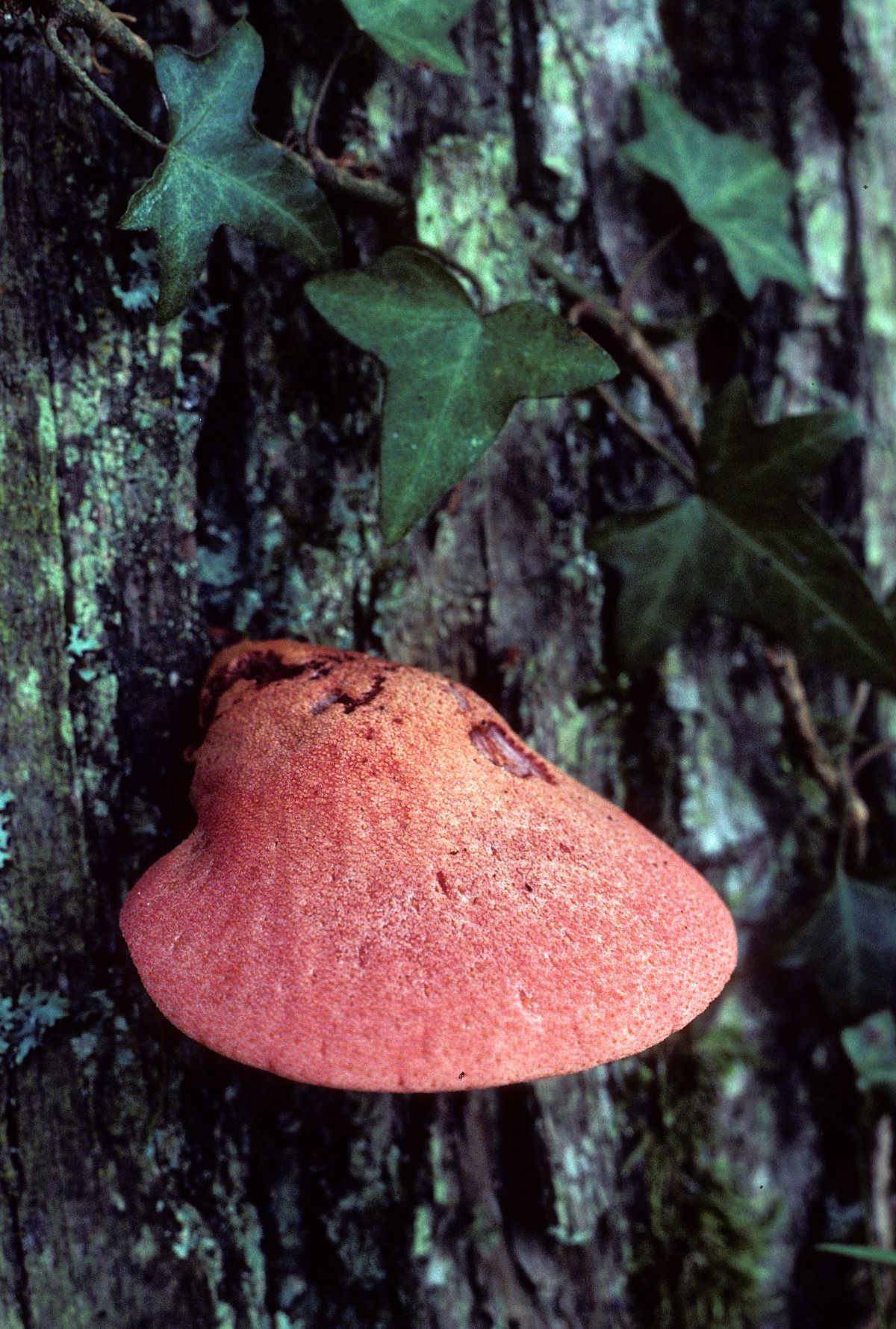
4. Amanita jacksonii: Jackson’s Slender Amanita
- Scientific Name: Amanita jacksonii
- Common Name: Jackson’s slender amanita, American slender Caesar, Eastern Caesar’s amanita
- Habitat: Woodlands across North America
- Toxicity: Non-toxic
Jackson’s Slender Amanita is a stunning red mushroom found in woodland regions throughout eastern Canada, the United States, and Mexico. It is one of the North American “Caesar” mushrooms and is often confused with Amanita ceaserea. However, A. ceaserea is strictly a European species. These two red fungi look very much alike, and if the Atlantic Ocean weren’t separating them, it would be difficult to tell them apart.
When young, the cap of Amanita jacksonii is red and oval-shaped. As it matures, the cap flattens and often develops a bump in the center. The red color gradually fades towards the edges, creating a beautiful gradient ranging from red in the center to orange and yellow on the sides. Mature caps can grow up to 5 inches in diameter.
Jackson’s Slender Amanita is known for its tall, slender yellow stem supporting the rounded, brilliant red cap. Underneath the cap, it has orange-yellow gills. This mushroom can grow up to 6″ tall.
This mushroom forms a mutually beneficial relationship with the roots of some hardwood tree species, especially oaks. It can grow singularly or in small groups on the ground of hardwood forests from late summer to early autumn.
Jackson’s Slender Amanita Mushroom is edible but often misidentified with highly toxic species from the same family, such as Amanita muscaria and Amanita phalloides. If you decide to forage this species, be very confident of your identification.

5. Phallaceae: The Stinkhorn Mushrooms
- Scientific Name: Phallaceae
- Common Name: Stinkhorn mushrooms
- Habitat: Various habitats worldwide, most commonly seen in mulch, disturbed land, gardens
- Toxicity: Non-toxic
The Stinkhorn family encompasses a variety of fungi with peculiar shapes and strong, unpleasant odors. While not all species within this family are red, several red-colored stinkhorn mushrooms stand out in their unique appearance.
Stinkhorn fungi bear fruiting bodies that often resemble various shapes, including antlers, stars, and squids. Their distinctive smell has been likened to that of decaying flesh or feces, attracting flies and other insects that aid in dispersing their spores.
Some notable species of red stinkhorn mushrooms include the Starfish fungus (Aseroe rubra), Basket stinkhorn (Clathrus ruber), Octopus stinkhorn (Clathrus archeri), Stinky squid (Pseudocolus fusiformis), and the Dog stinkhorn (Mutinus elegans).
Stinkhorns are saprophytic fungi that feed on decaying organic matter. They can be found in various environments, including gardens, lawns, and woodlands.
While their appearance and odor may suggest otherwise, most species of stinkhorn mushrooms are generally considered non-toxic. However, due to their unpleasant smell and appearance, they are not typically consumed, at least as mature specimens. Stinkhorns grow from egg sacs, and these eggs are considered a delicacy by many. They taste a bit like radishes and even have some of the radish “crunch.”
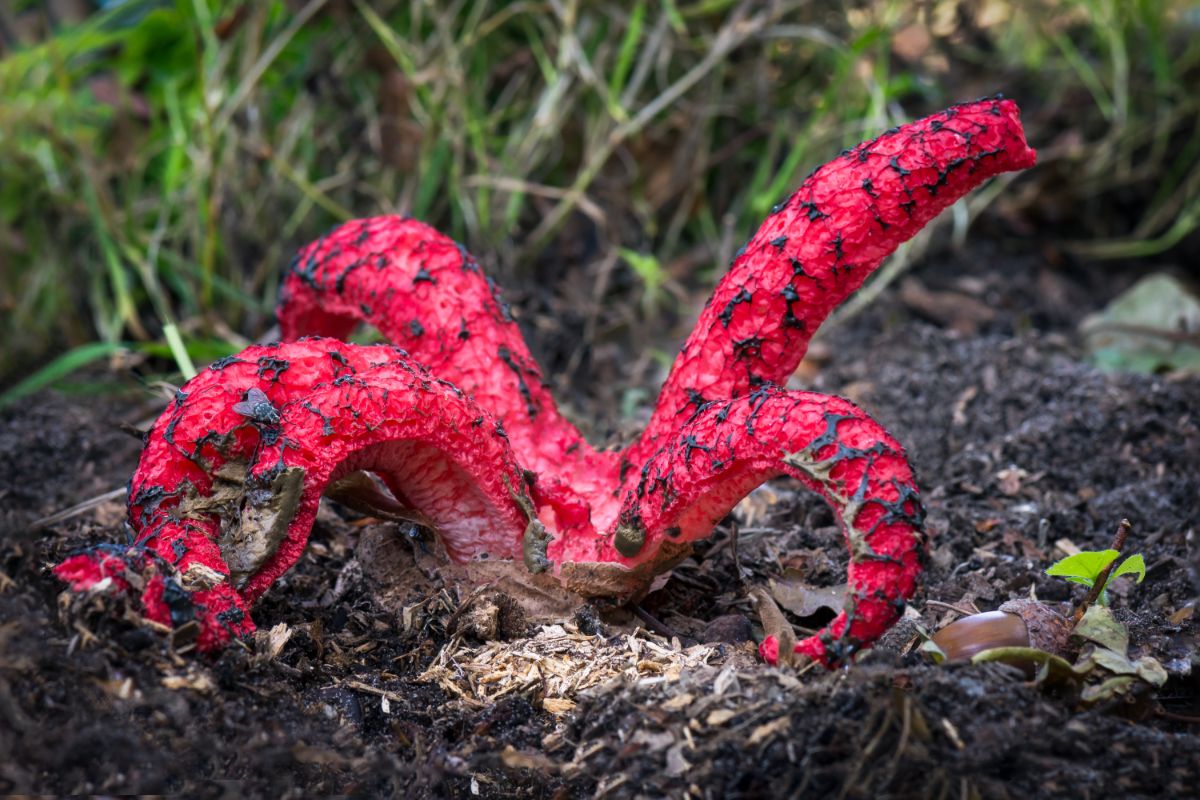
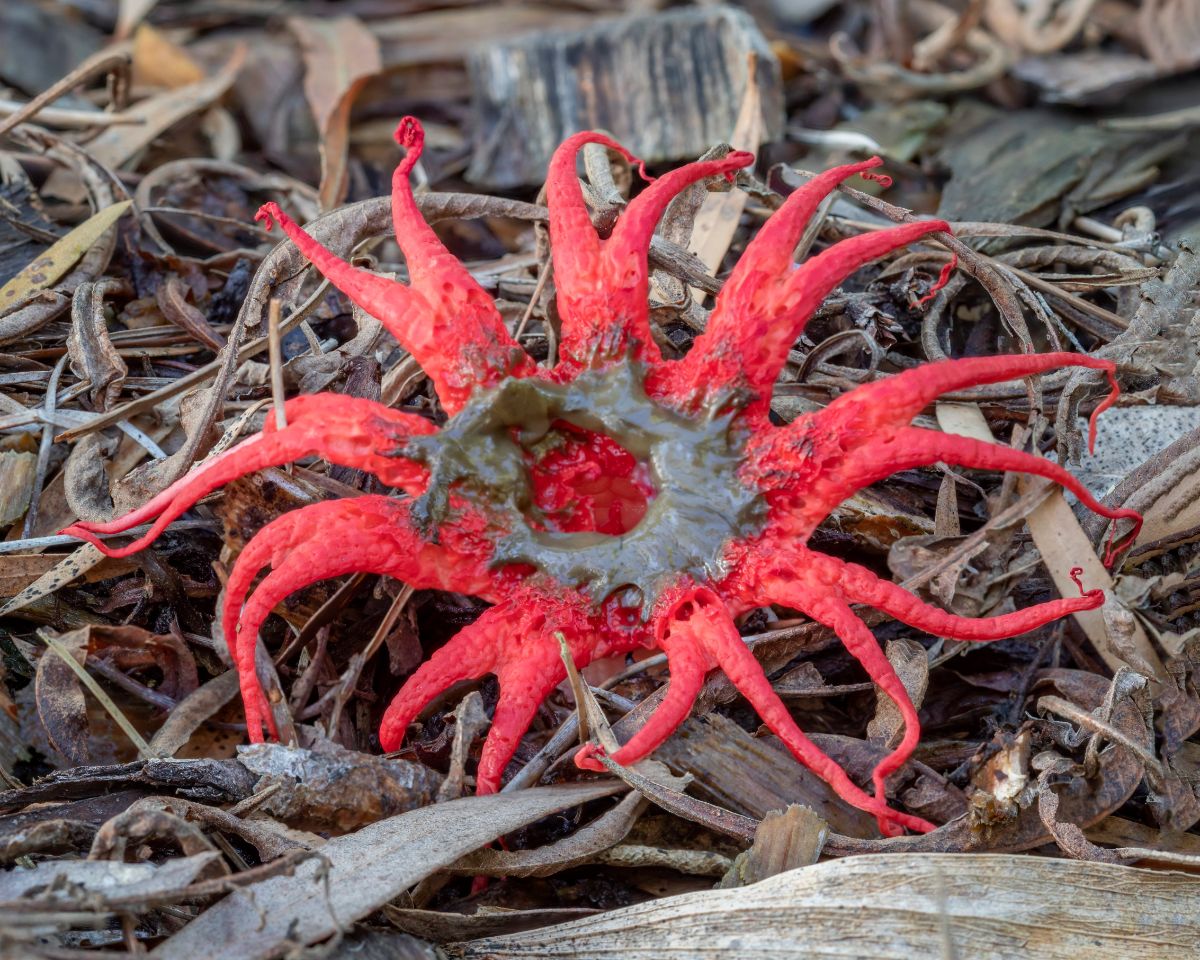
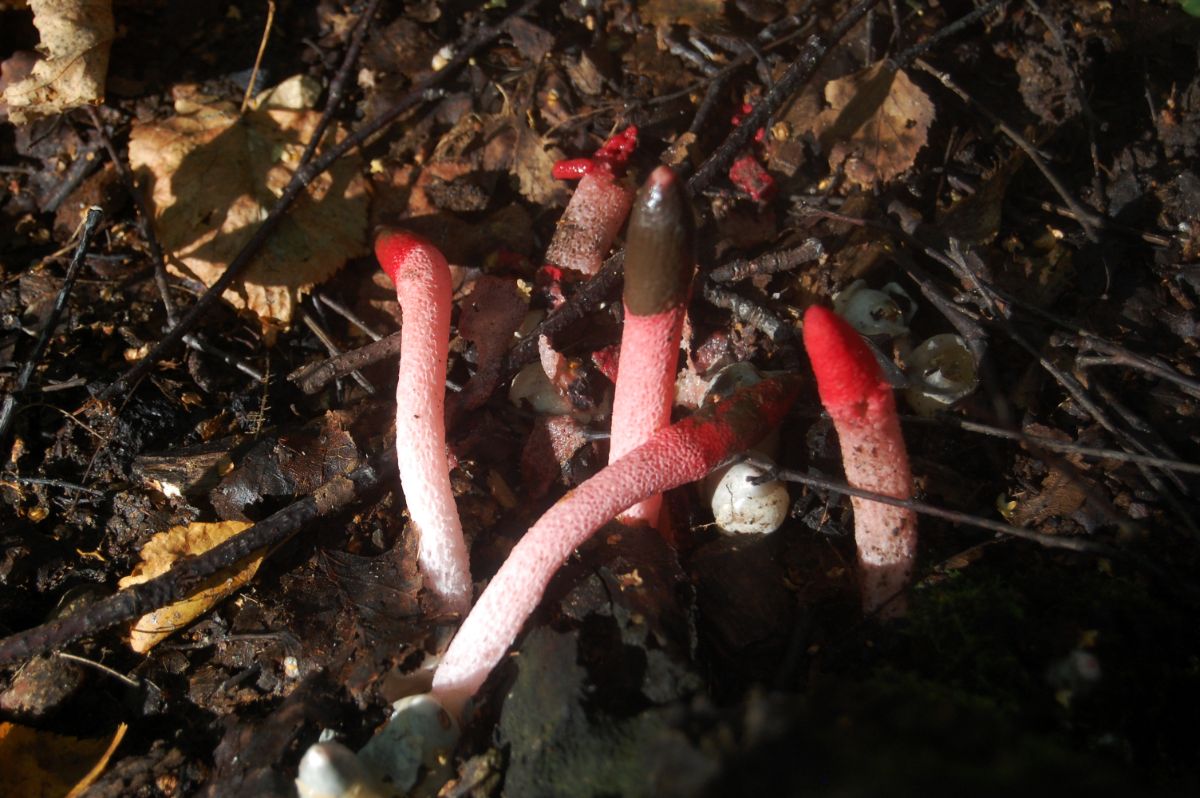
6. Cantharellus cinnabarinus: The Cinnabar-Red Chanterelle
- Scientific Name: Cantharellus cinnabarinus
- Common Name: Cinnabar red chanterelle, Fire chanterelle, Red chanterelle
- Habitat: Broadleaf or mixed forests
- Toxicity: Non-toxic
The cinnabar red chanterelle is an edible species easily identifiable by its small size and vibrant color. The cap rarely exceeds 2 inches in diameter and has a smooth surface with a trumpet or funnel shape, often with curled edges. Underneath the cap, you will find forked false gills that are slightly lighter in color than the cap. The stem of the red mushroom is thin and matches the overall color of the cap, becoming lighter at the base.
This red fungi species is usually found on the ground of broadleaf forests or mixed broadleaf-conifer forests during late summer and early fall. The cinnabar red chanterelle is edible and is highly prized for its unique flavor and color. It smells sweet, but this mushroom imparts a slightly peppery flavor when cooked.
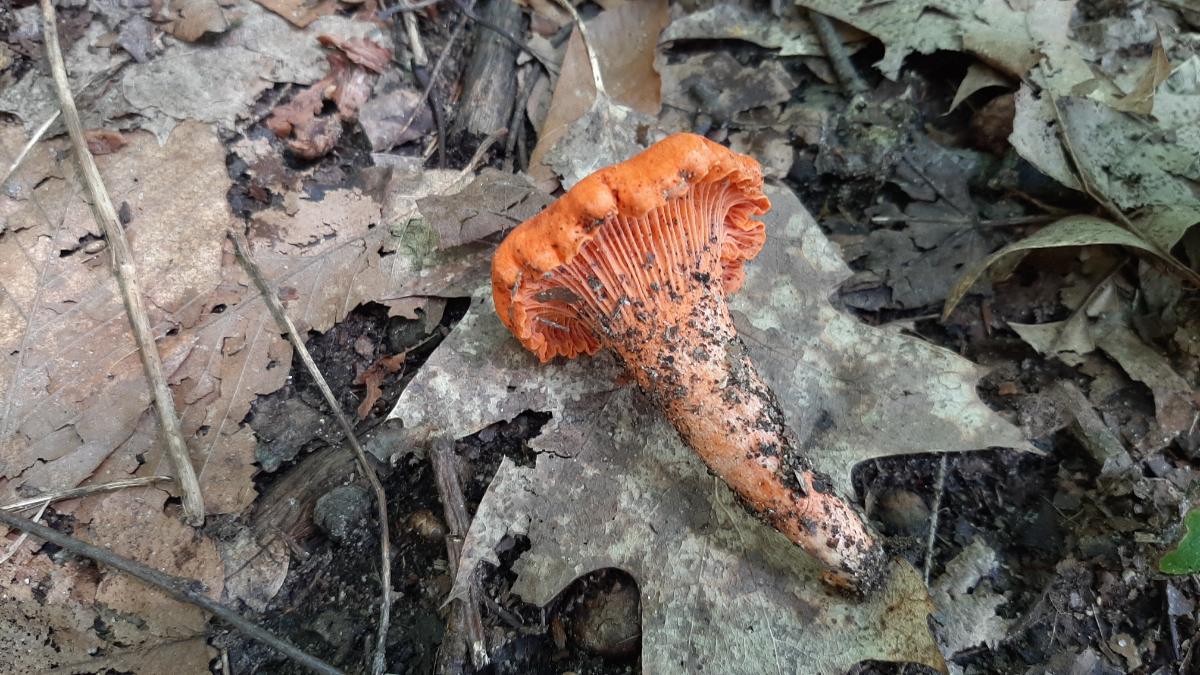
7. Butyriboletus frostii: Frost’s Bolete
- Scientific Name:Butyriboletus frostii
- Common Name: Frost’s Bolete, Candy Apple Bolete
- Habitat: Oaks, hardwoods
- Toxicity: Non-toxic
Frost’s Bolete, or the Apple Bolete, is a species of fungi found in Northern and Central America, Mexico, and Costa Rica. It is easily identified by its shiny dark-red cap and deeply netted red stem. The cap starts out rounded but flattens out as the mushroom ages.
Frost’s bolete forms a mutually beneficial symbiotic connection with the roots of some hardwood tree species, particularly oaks. It grows in small groups or solitarily and can be found on the ground of hardwood forests from late summer to early autumn.
Frost’s bolete is non-toxic and edible. However, if you choose to forage this red fungi species, do so with caution. Several red-capped toxic bolete species look passingly similar.
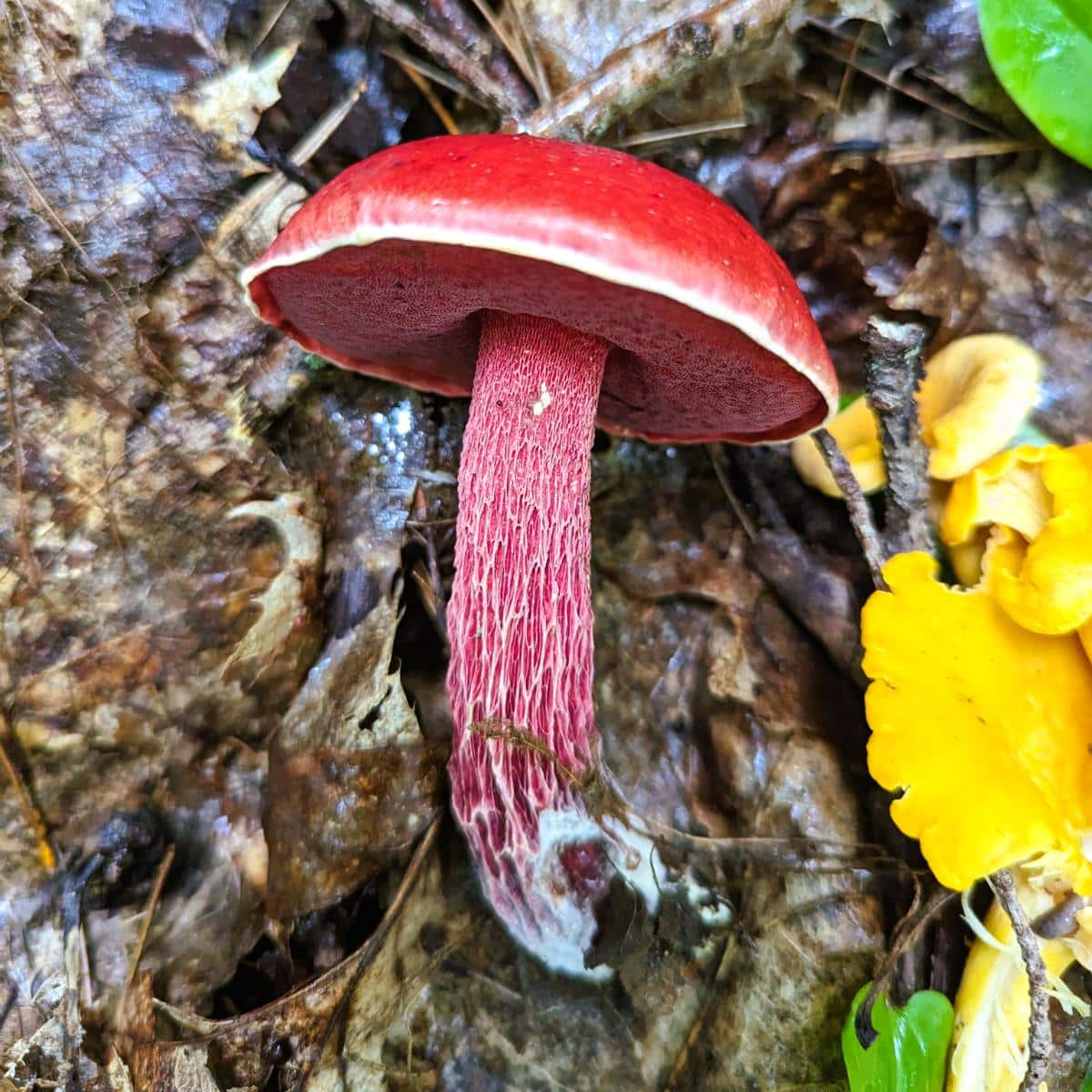
8. Sarcoscypha coccinea: The Scarlet Elf Cup
- Scientific Name:Sarcoscypha coccinea (spp.)
- Common Name: Scarlet Elf Cup, Scarlet Cup, Red Cup, Moss Cup, Fairies Baths
- Habitat: Decaying hardwood
- Toxicity: Non-toxic
The Scarlet Elf Cup, or Scarlet Cup, is a bright red, cup-shaped fungus found mainly in deciduous forests worldwide. There are actually four species of scarlet elf cup fungi in North America, but they can be challenging to differentiate without a microscope.
The scarlet elf cup is easily identifiable by its vibrant red, cup-shaped cap. The cap is shiny and reveals whitish flesh when cut. Elf cup flesh is extremely thin, to the point it is almost see-through in many cases. Stems are either very stubby or nonexistent.
This mushroom prefers humid environments and is often spotted around hazelnut, various maples, alder, willow, and aspen. It feeds on dead organic matter like decaying fallen tree trunks and dry branches. These red fungi often grow in scattered or clustered groupings.
Scarlet elf cups are non-toxic and edible but not widely foraged. Their small size combined with a chewy texture makes them not an ideal ingredient. In some cultures, they are used as a garnish in salads or on buttered bread. When fried, they make a nice crouton-like garnish.
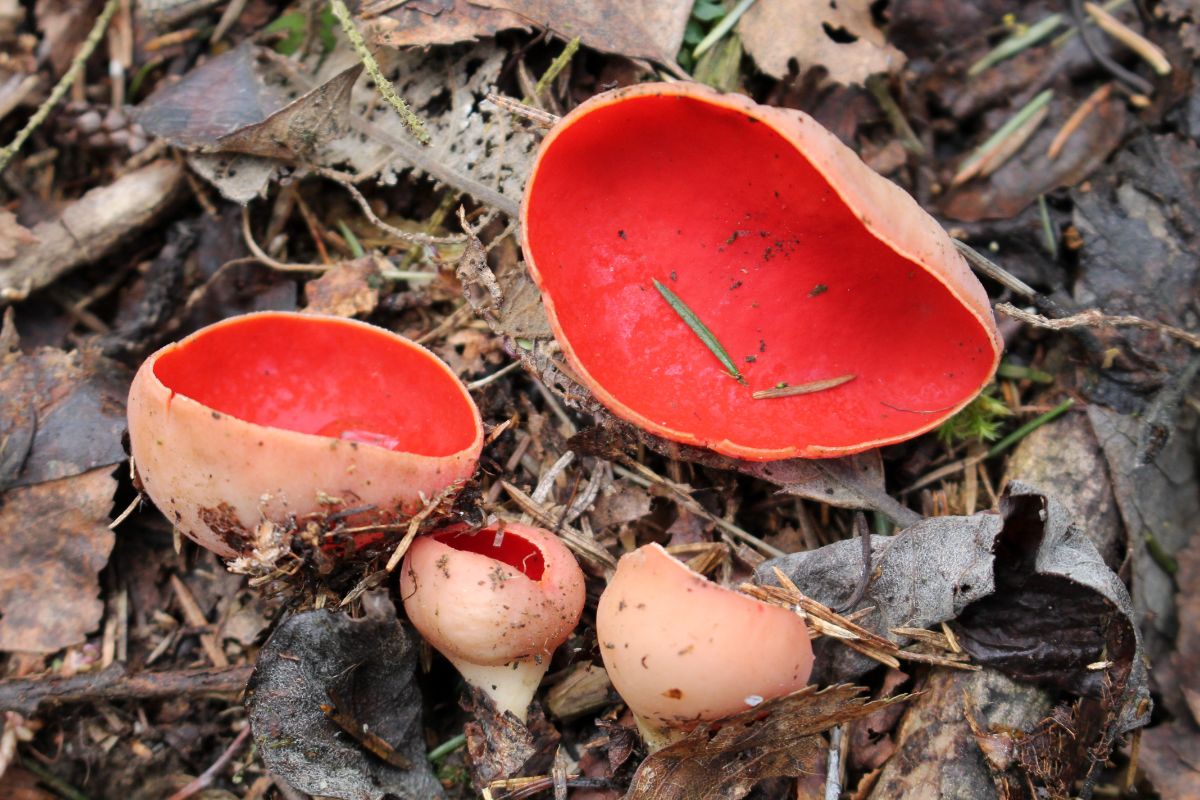
9. Hygrocybe coccinea: The Scarlet Waxcap
- Scientific Name: Hygrocybe coccinea
- Common Name: Scarlet waxcap, Scarlet hood
- Habitat: Grasslands
- Toxicity: Non-toxic
The scarlet waxcap, or scarlet hood, is a small red mushroom distributed around the world, including North America. It is often found growing in small clusters in grassy areas. It is usually found in late summer, autumn, or even early winter.
The scarlet waxcap derives its name from its bright red cap, which is covered in a waxy substance. The caps of these mushrooms typically measure about 2 inches in diameter and the stalks average 2 inches tall. This species belongs to the genus Hygrocybe and is closely related to other waxy caps, such as the Red-staining waxy cap.
While the scarlet waxcap is edible, it is not often foraged because of its relatively bland taste, waxy texture, and insignificant bulk. It can very easily be mistaken for Hygrocybe punicea (Crimson scarlet waxy cap), which is also regarded as edible but has been reported to cause gastrointestinal problems for some people.
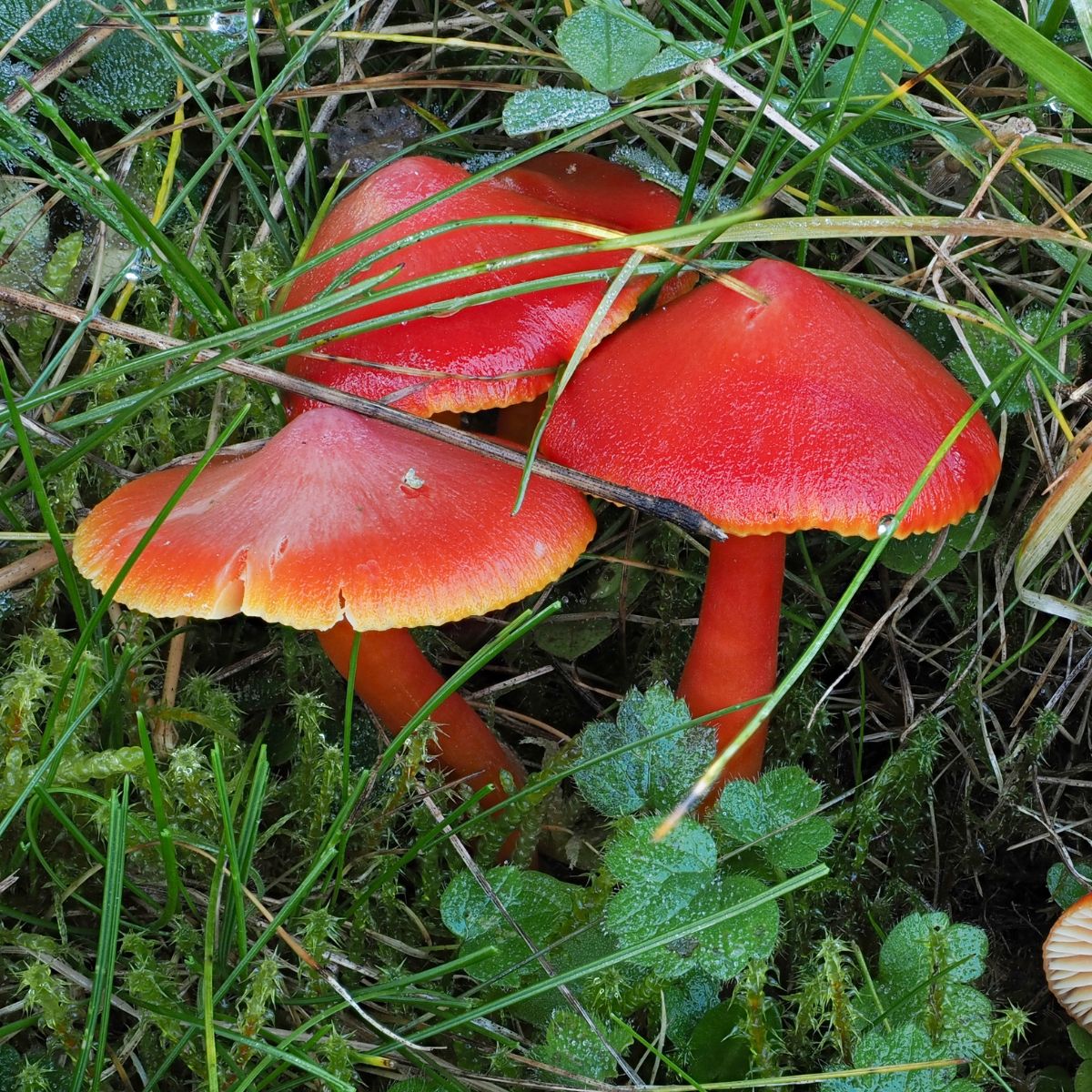
10. Xerocomellus chrysenteron: The Red Cracking Bolete
- Scientific Name: Xerocomellus chrysenteron
- Common Name: Red cracking bolete
- Habitat: Hardwoods, especially beech
- Toxicity: Non-toxic
The red cracking bolete is an edible fungus that can be found from July through October. The red cracking bolete gets its name from the cracks that often appear on its brown or reddish-brown cap, revealing the light red flesh beneath. The cap has a smooth surface and can measure up to 5.9 inches. The underside of the cap features bright yellow spores.
The stem of the red cracking bolete is a mix of red and yellow and reaches a height of about 3.9 inches. When cut, the flesh of this mushroom is yellowish and emits a pleasant curry-like aroma. The stem flesh is whitish but turns blue when cut.
This red fungi species is found across temperate zones and favors coniferous forests.
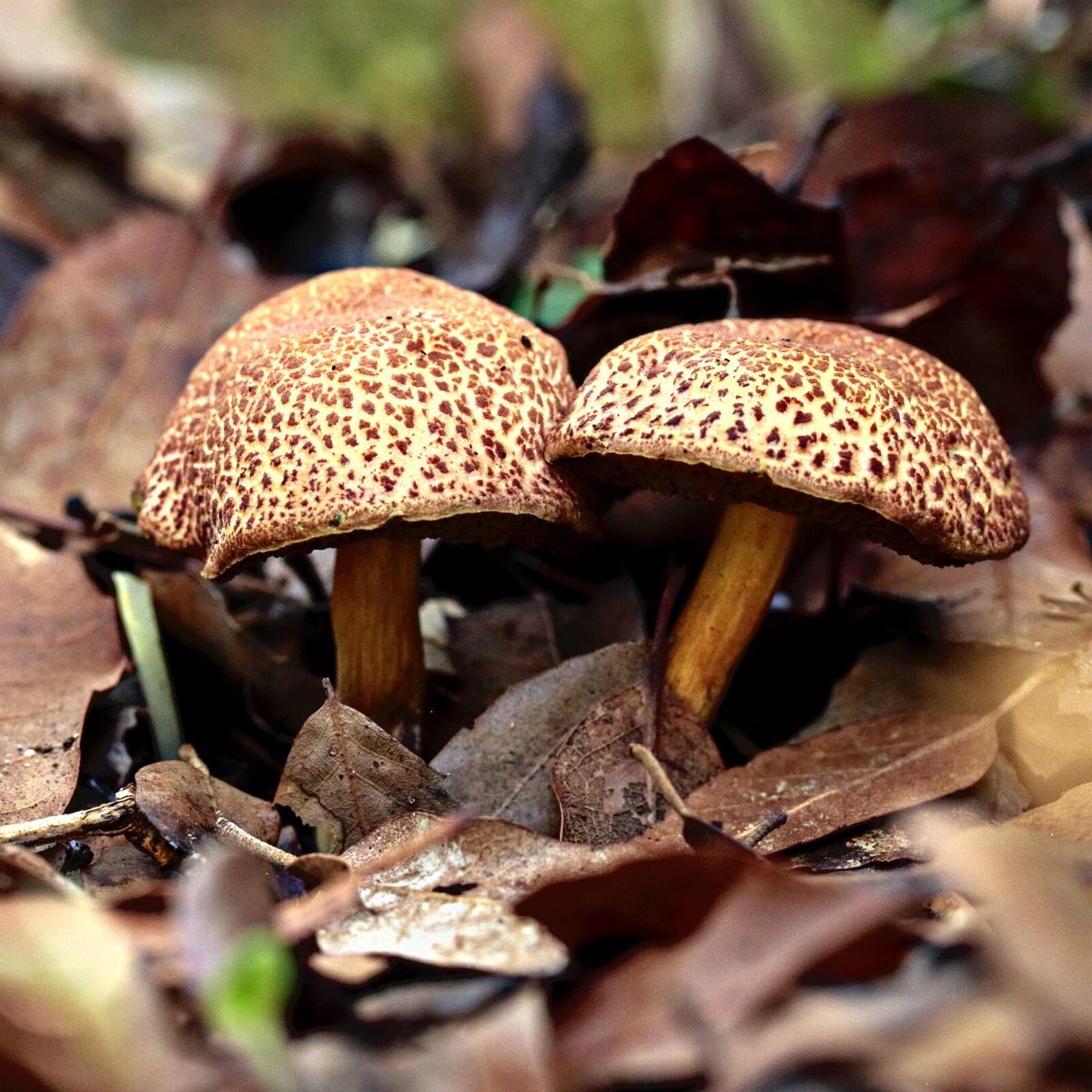
11. Russula xerampelina: Crab Brittlegill
- Scientific Name: Russula xerampelina
- Common Name: Crab brittlegill, Shrimp mushroom
- Habitat: Coniferous forests
- Toxicity: Non-toxic
The crab brittlegill is an edible member of the Russula family and is sought after for its unique flavor and crunchy texture. This red fungi species is commonly found in coniferous forests throughout North America and Europe.
Crab brittlegills have dome-shaped caps ranging in color from wine-red to brownish-red as they age. The gills underneath the cap are cream-colored and widely spaced, and the stalk is white. The stem, gills, and flesh all stain brown when cut or bruised.
The mushroom earns its name by its very unique and strong scent; it smells like boiled shellfish! As it matures or dries out, the smell intensifies. When cooked, the flavor is a bit more mild but still shellfish-y.
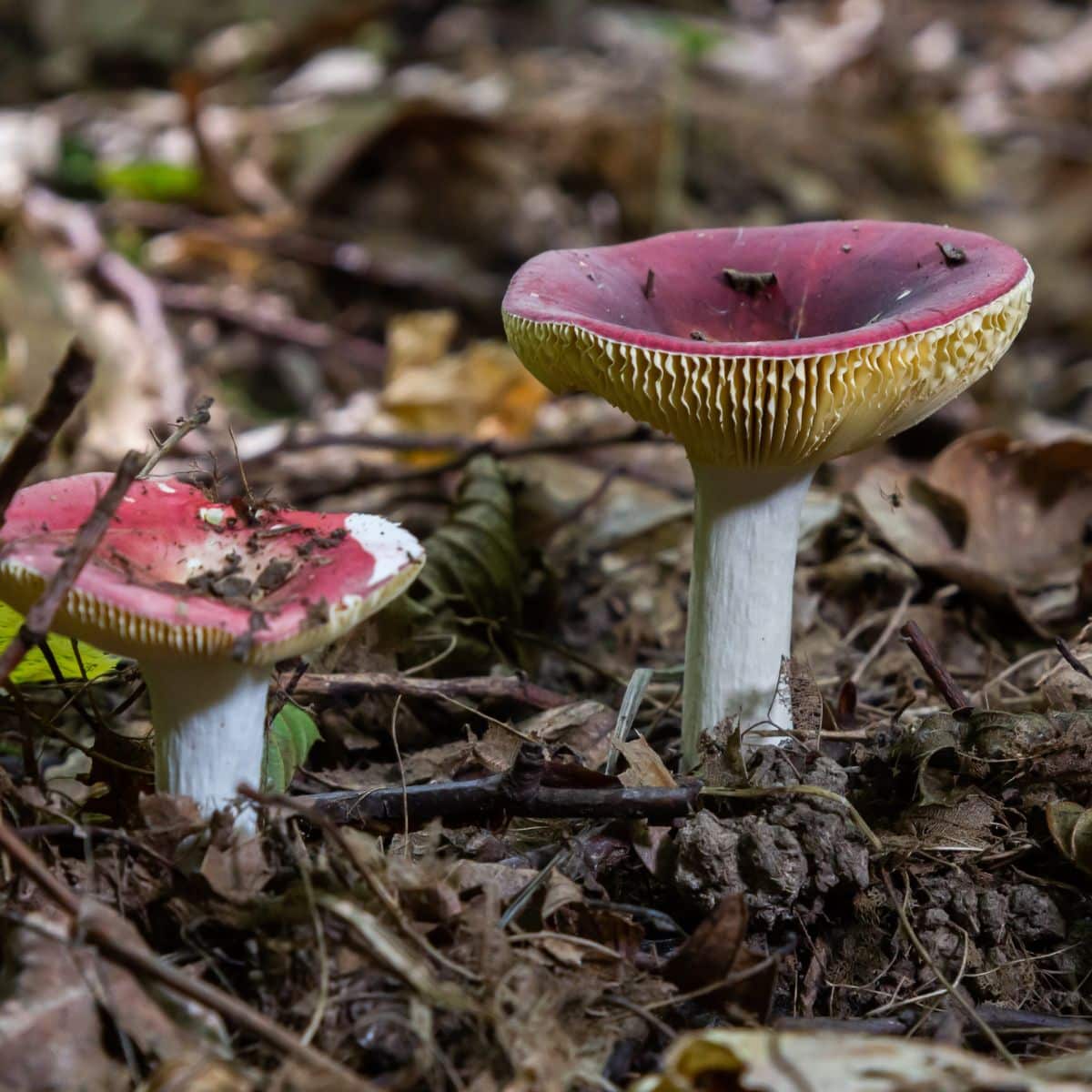
12: Hydnellum peckii, Devil’s Tooth
- Scientific Name: Hydnellum peckii
- Common Name: Strawberries and cream, Bleeding Hydnellum, Red-juice tooth, Peck’s hydnum, Bleeding tooth fungus, and devil’s tooth
- Habitat: On the ground, under conifer trees
- Toxicity: Non-toxic
The rather bizarre devil’s tooth fungus is quite the site when it is “bleeding.” However, when it isn’t emitting red droplets, it is a rather unassuming looking mushroom – a bland cream or grayish color that quickly darkens as it matures.
The Devil’s Tooth fungus is most commonly encountered in North America and Europe. In the United States, this fungus is most commonly found in the Pacific Northwest, but its range extends from Alaska to North Carolina.
This red fungi species forms a symbiotic relationship with coniferous trees, growing among their roots and exchanging nutrients to mutually benefit. It is known to associate with pines, western hemlock, Douglas fir, and Sitka spruce. Its fruiting bodies grow on the ground, either singly or in scattered groups.
Young specimens have a whitish cap with a brighter white edge and exude a thick, bright red fluid that looks like blood. This fluid looks like blood droplets on the cap surface, which then pool together to cover the surface of the mushroom.
When young and covered with bloody droplets, this fungus is pretty easy to identify. However, with age, the cap turns grayish brown with a darkened brownish center before turning black and decaying. It is extremely plain looking at this point compared to its younger self. It often gets overlooked at this point since its flashiness is gone.
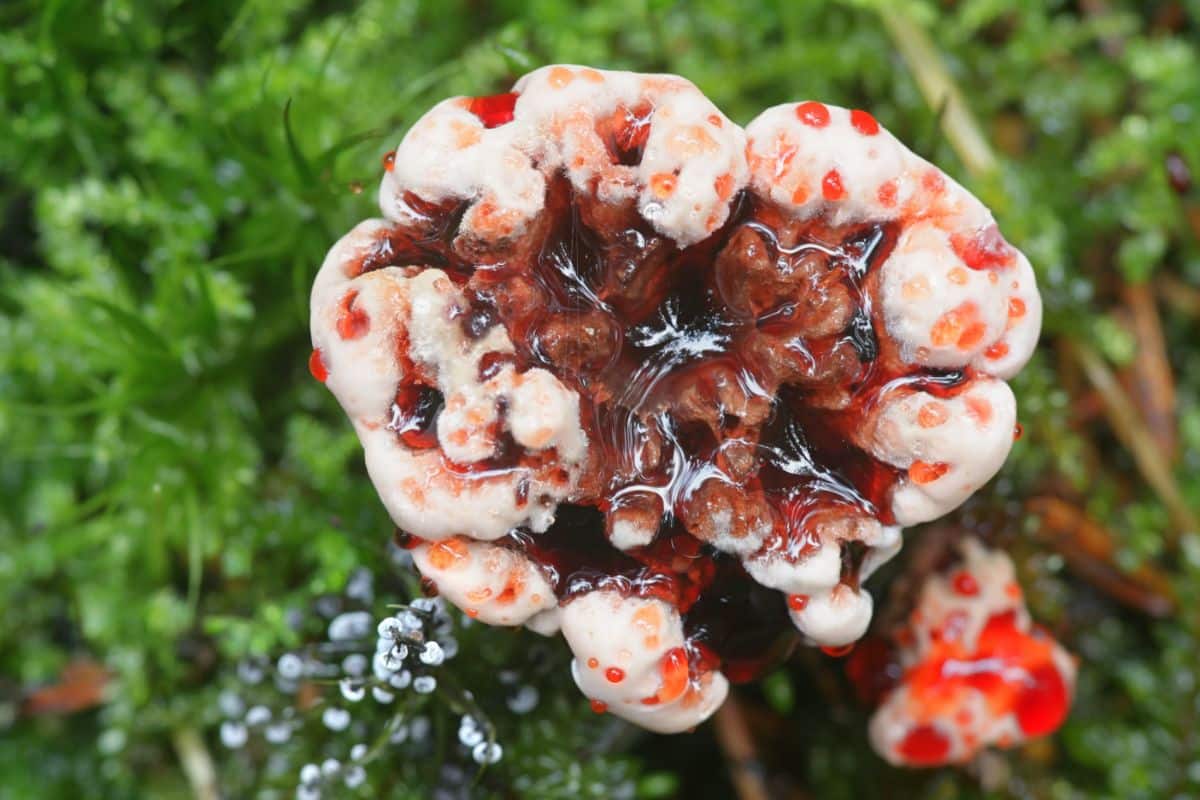
Common Questions About Red Mushrooms
Are red mushrooms safe to touch?
Touching any mushroom is fine — toxicity only happens when you ingest (eat) a poisonous mushroom. There is one deadly poisonous red fungi species from Asia that reportedly causes skin irritation when touched (and death when eaten). However, even then, you aren’t going to die from touching it.
It’s completely fine to touch and handle all North American mushroom species. Care should be taken with small children, of course, who put their hands in their mouths a lot and may accidentally ingest a mushroom that way. If you’re an adult and can keep your hands out of your mouth, feel free to touch any mushroom.
Are bright red mushrooms poisonous?
Depends on the species. There are lots of red fungi, as you can see from the list above, and their edibility status varies widely. How To Tell If A Mushroom Is Poisonous
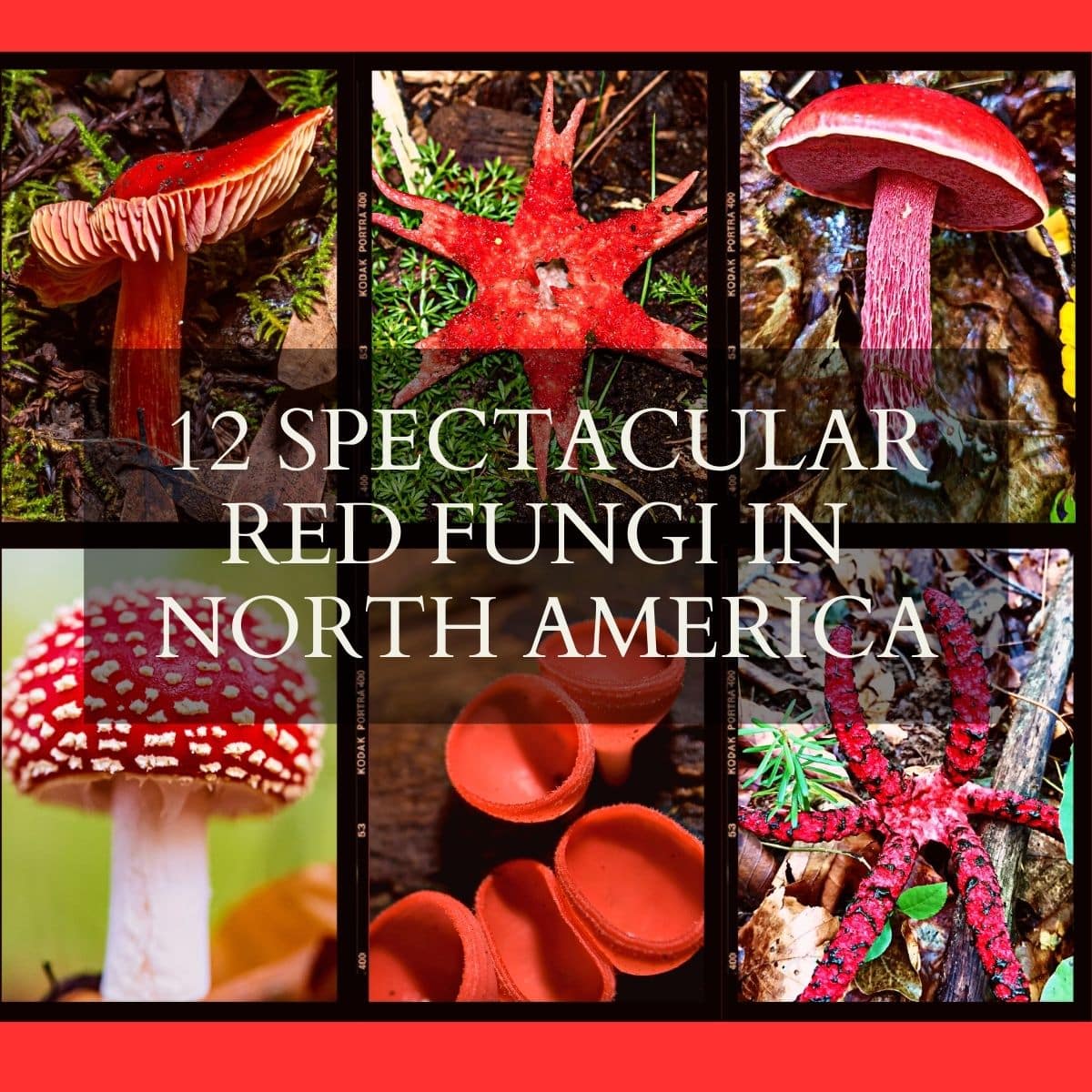





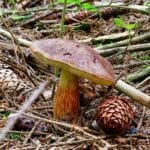
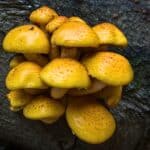
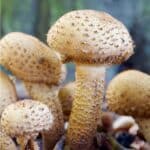
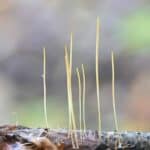
Leave a Reply